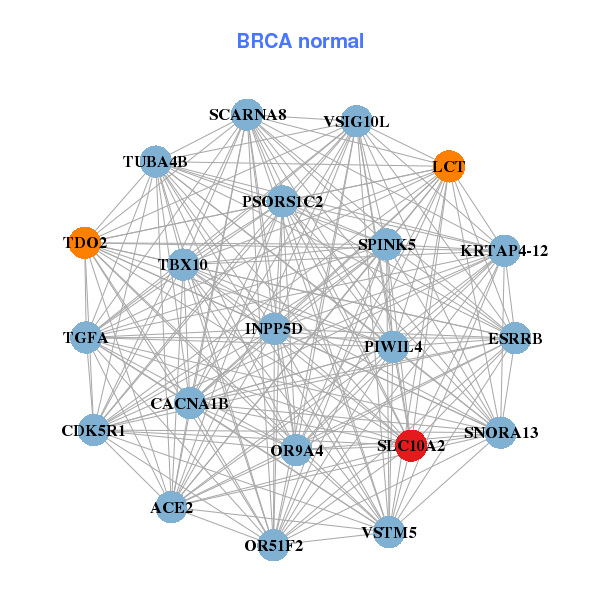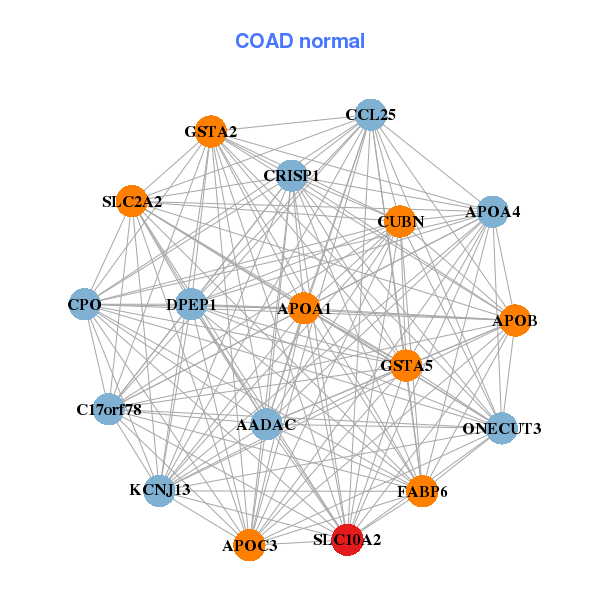|
||||||||||||||||||||||||||||||||||||||||||||||||||||||||||||||||||||||||||||||||||||||||||||||||||||||||||||||||||||||||||||||||||||||||||||||||||||||||||||||||||||||||||||||||||||||||||||||||||||||||||||||||||||||||||||||||||||||||||||||||||||||||||||||||||||||||||||||||||||||||||||||||||||||||||||||||||||||||||||||||||||||||||||||||||||||||||||||||||||||||
| |
| Phenotypic Information (metabolism pathway, cancer, disease, phenome) |
| |
| |
| Gene-Gene Network Information: Co-Expression Network, Interacting Genes & KEGG |
| |
|
| Gene Summary for SLC10A2 |
| Basic gene info. | Gene symbol | SLC10A2 |
| Gene name | solute carrier family 10 (sodium/bile acid cotransporter), member 2 | |
| Synonyms | ASBT|IBAT|ISBT|NTCP2|PBAM | |
| Cytomap | UCSC genome browser: 13q33 | |
| Genomic location | chr13 :103696347-103719196 | |
| Type of gene | protein-coding | |
| RefGenes | NM_000452.2, | |
| Ensembl id | ENSG00000125255 | |
| Description | Na(+)-dependent ileal bile acid transporterileal apical sodium-dependent bile acid transporterileal sodium-dependent bile acid transporterileal sodium/bile acid cotransportersodium/taurocholate cotransporting polypeptide, ilealsolute carrier family 1 | |
| Modification date | 20141207 | |
| dbXrefs | MIM : 601295 | |
| HGNC : HGNC | ||
| Ensembl : ENSG00000125255 | ||
| HPRD : 03189 | ||
| Vega : OTTHUMG00000017313 | ||
| Protein | UniProt: Q12908 go to UniProt's Cross Reference DB Table | |
| Expression | CleanEX: HS_SLC10A2 | |
| BioGPS: 6555 | ||
| Gene Expression Atlas: ENSG00000125255 | ||
| The Human Protein Atlas: ENSG00000125255 | ||
| Pathway | NCI Pathway Interaction Database: SLC10A2 | |
| KEGG: SLC10A2 | ||
| REACTOME: SLC10A2 | ||
| ConsensusPathDB | ||
| Pathway Commons: SLC10A2 | ||
| Metabolism | MetaCyc: SLC10A2 | |
| HUMANCyc: SLC10A2 | ||
| Regulation | Ensembl's Regulation: ENSG00000125255 | |
| miRBase: chr13 :103,696,347-103,719,196 | ||
| TargetScan: NM_000452 | ||
| cisRED: ENSG00000125255 | ||
| Context | iHOP: SLC10A2 | |
| cancer metabolism search in PubMed: SLC10A2 | ||
| UCL Cancer Institute: SLC10A2 | ||
| Assigned class in ccmGDB | B - This gene belongs to cancer gene. | |
| Top |
| Phenotypic Information for SLC10A2(metabolism pathway, cancer, disease, phenome) |
| Cancer | CGAP: SLC10A2 |
| Familial Cancer Database: SLC10A2 | |
| * This gene is included in those cancer gene databases. |
|
|
|
|
|
| . | ||||||||||||||||||||||||||||||||||||||||||||||||||||||||||||||||||||||||||||||||||||||||||||||||||||||||||||||||||||||||||||||||||||||||||||||||||||||||||||||||||||||||||||||||||||||||||||||||||||||||||||||||||||||||||||||||||||||||||||||||||||||||||||||||||||||||||||||||||||||||||||||||||||||||||||||||||||||||||||||||||||||||||||||||||||||||||||||||||
Oncogene 1 | Significant driver gene in | |||||||||||||||||||||||||||||||||||||||||||||||||||||||||||||||||||||||||||||||||||||||||||||||||||||||||||||||||||||||||||||||||||||||||||||||||||||||||||||||||||||||||||||||||||||||||||||||||||||||||||||||||||||||||||||||||||||||||||||||||||||||||||||||||||||||||||||||||||||||||||||||||||||||||||||||||||||||||||||||||||||||||||||||||||||||||||||||||||||||
| cf) number; DB name 1 Oncogene; http://nar.oxfordjournals.org/content/35/suppl_1/D721.long, 2 Tumor Suppressor gene; https://bioinfo.uth.edu/TSGene/, 3 Cancer Gene Census; http://www.nature.com/nrc/journal/v4/n3/abs/nrc1299.html, 4 CancerGenes; http://nar.oxfordjournals.org/content/35/suppl_1/D721.long, 5 Network of Cancer Gene; http://ncg.kcl.ac.uk/index.php, 1Therapeutic Vulnerabilities in Cancer; http://cbio.mskcc.org/cancergenomics/statius/ |
| REACTOME_METABOLISM_OF_LIPIDS_AND_LIPOPROTEINS | |
| OMIM | 601295; gene. 613291; phenotype. |
| Orphanet | |
| Disease | KEGG Disease: SLC10A2 |
| MedGen: SLC10A2 (Human Medical Genetics with Condition) | |
| ClinVar: SLC10A2 | |
| Phenotype | MGI: SLC10A2 (International Mouse Phenotyping Consortium) |
| PhenomicDB: SLC10A2 | |
| Mutations for SLC10A2 |
| * Under tables are showing count per each tissue to give us broad intuition about tissue specific mutation patterns.You can go to the detailed page for each mutation database's web site. |
| There's no structural variation information in COSMIC data for this gene. |
| * From mRNA Sanger sequences, Chitars2.0 arranged chimeric transcripts. This table shows SLC10A2 related fusion information. |
| ID | Head Gene | Tail Gene | Accession | Gene_a | qStart_a | qEnd_a | Chromosome_a | tStart_a | tEnd_a | Gene_a | qStart_a | qEnd_a | Chromosome_a | tStart_a | tEnd_a |
| Top |
| Mutation type/ Tissue ID | brca | cns | cerv | endome | haematopo | kidn | Lintest | liver | lung | ns | ovary | pancre | prost | skin | stoma | thyro | urina | |||
| Total # sample | 1 | |||||||||||||||||||
| GAIN (# sample) | 1 | |||||||||||||||||||
| LOSS (# sample) |
| cf) Tissue ID; Tissue type (1; Breast, 2; Central_nervous_system, 3; Cervix, 4; Endometrium, 5; Haematopoietic_and_lymphoid_tissue, 6; Kidney, 7; Large_intestine, 8; Liver, 9; Lung, 10; NS, 11; Ovary, 12; Pancreas, 13; Prostate, 14; Skin, 15; Stomach, 16; Thyroid, 17; Urinary_tract) |
| Top |
|
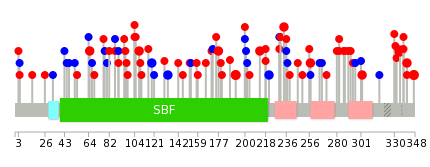 |
| Top |
| Stat. for Non-Synonymous SNVs (# total SNVs=46) | (# total SNVs=20) |
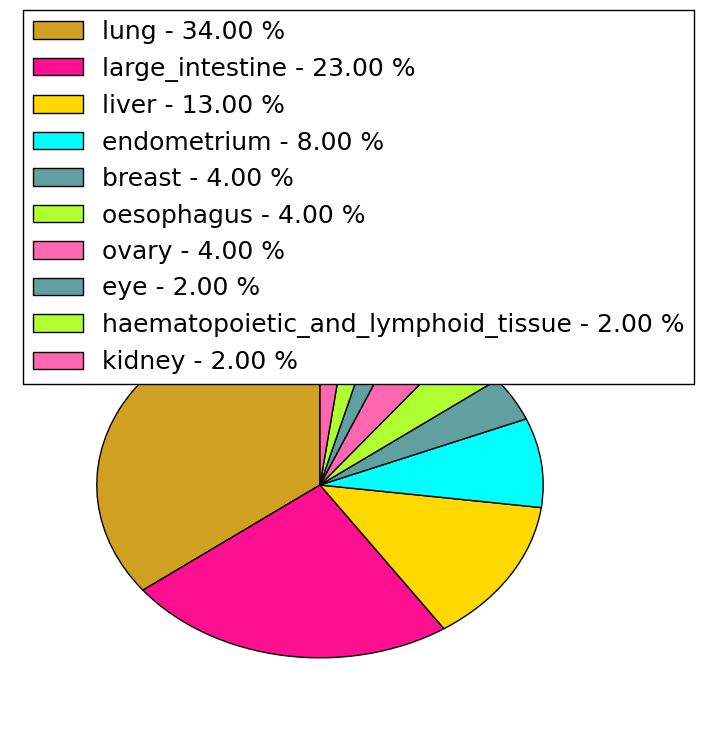 | 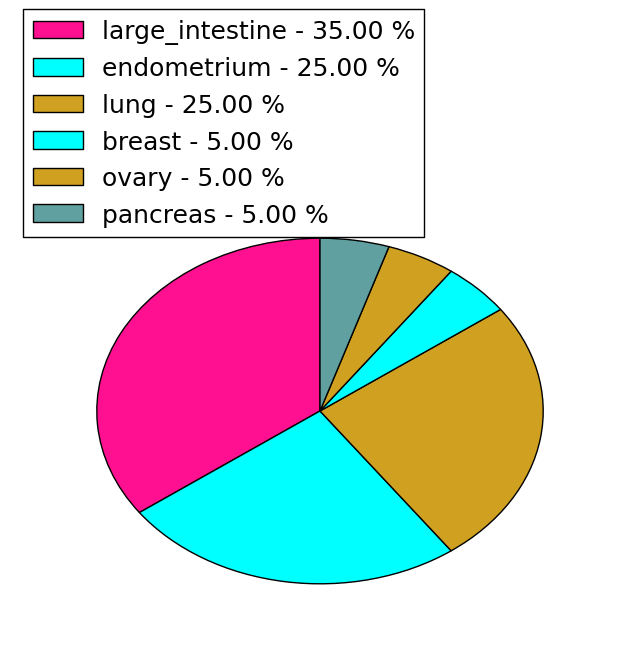 |
(# total SNVs=0) | (# total SNVs=0) |
| Top |
| * When you move the cursor on each content, you can see more deailed mutation information on the Tooltip. Those are primary_site,primary_histology,mutation(aa),pubmedID. |
| GRCh37 position | Mutation(aa) | Unique sampleID count |
| chr13:103698526-103698526 | p.S335L | 5 |
| chr13:103704980-103704980 | p.I192T | 3 |
| chr13:103698491-103698491 | p.E347K | 3 |
| chr13:103703668-103703668 | p.P234S | 2 |
| chr13:103701788-103701788 | p.T257M | 2 |
| chr13:103718243-103718243 | p.V119V | 2 |
| chr13:103703705-103703705 | p.I221I | 2 |
| chr13:103718407-103718407 | p.P65S | 2 |
| chr13:103701714-103701714 | p.E282Q | 2 |
| chr13:103703730-103703730 | p.G213E | 2 |
| Top |
|
 |
| Point Mutation/ Tissue ID | 1 | 2 | 3 | 4 | 5 | 6 | 7 | 8 | 9 | 10 | 11 | 12 | 13 | 14 | 15 | 16 | 17 | 18 | 19 | 20 |
| # sample | 2 | 3 | 10 | 2 | 12 | 5 | 1 | 1 | 2 | 24 | 2 | 7 | ||||||||
| # mutation | 2 | 3 | 10 | 2 | 12 | 5 | 1 | 1 | 2 | 24 | 2 | 9 | ||||||||
| nonsynonymous SNV | 2 | 2 | 5 | 2 | 9 | 3 | 2 | 17 | 1 | 4 | ||||||||||
| synonymous SNV | 1 | 5 | 3 | 2 | 1 | 1 | 7 | 1 | 5 |
| cf) Tissue ID; Tissue type (1; BLCA[Bladder Urothelial Carcinoma], 2; BRCA[Breast invasive carcinoma], 3; CESC[Cervical squamous cell carcinoma and endocervical adenocarcinoma], 4; COAD[Colon adenocarcinoma], 5; GBM[Glioblastoma multiforme], 6; Glioma Low Grade, 7; HNSC[Head and Neck squamous cell carcinoma], 8; KICH[Kidney Chromophobe], 9; KIRC[Kidney renal clear cell carcinoma], 10; KIRP[Kidney renal papillary cell carcinoma], 11; LAML[Acute Myeloid Leukemia], 12; LUAD[Lung adenocarcinoma], 13; LUSC[Lung squamous cell carcinoma], 14; OV[Ovarian serous cystadenocarcinoma ], 15; PAAD[Pancreatic adenocarcinoma], 16; PRAD[Prostate adenocarcinoma], 17; SKCM[Skin Cutaneous Melanoma], 18:STAD[Stomach adenocarcinoma], 19:THCA[Thyroid carcinoma], 20:UCEC[Uterine Corpus Endometrial Carcinoma]) |
| Top |
| * We represented just top 10 SNVs. When you move the cursor on each content, you can see more deailed mutation information on the Tooltip. Those are primary_site, primary_histology, mutation(aa), pubmedID. |
| Genomic Position | Mutation(aa) | Unique sampleID count |
| chr13:103698526 | p.S335L | 4 |
| chr13:103701788 | p.I78I | 2 |
| chr13:103718407 | p.V119V | 2 |
| chr13:103718317 | p.P65S | 2 |
| chr13:103703668 | p.G108R | 2 |
| chr13:103698491 | p.T257M | 2 |
| chr13:103718243 | p.E347K | 2 |
| chr13:103698508 | p.G341E | 2 |
| chr13:103718366 | p.L95I | 2 |
| chr13:103718278 | p.P234S | 2 |
| * Copy number data were extracted from TCGA using R package TCGA-Assembler. The URLs of all public data files on TCGA DCC data server were gathered on Jan-05-2015. Function ProcessCNAData in TCGA-Assembler package was used to obtain gene-level copy number value which is calculated as the average copy number of the genomic region of a gene. |
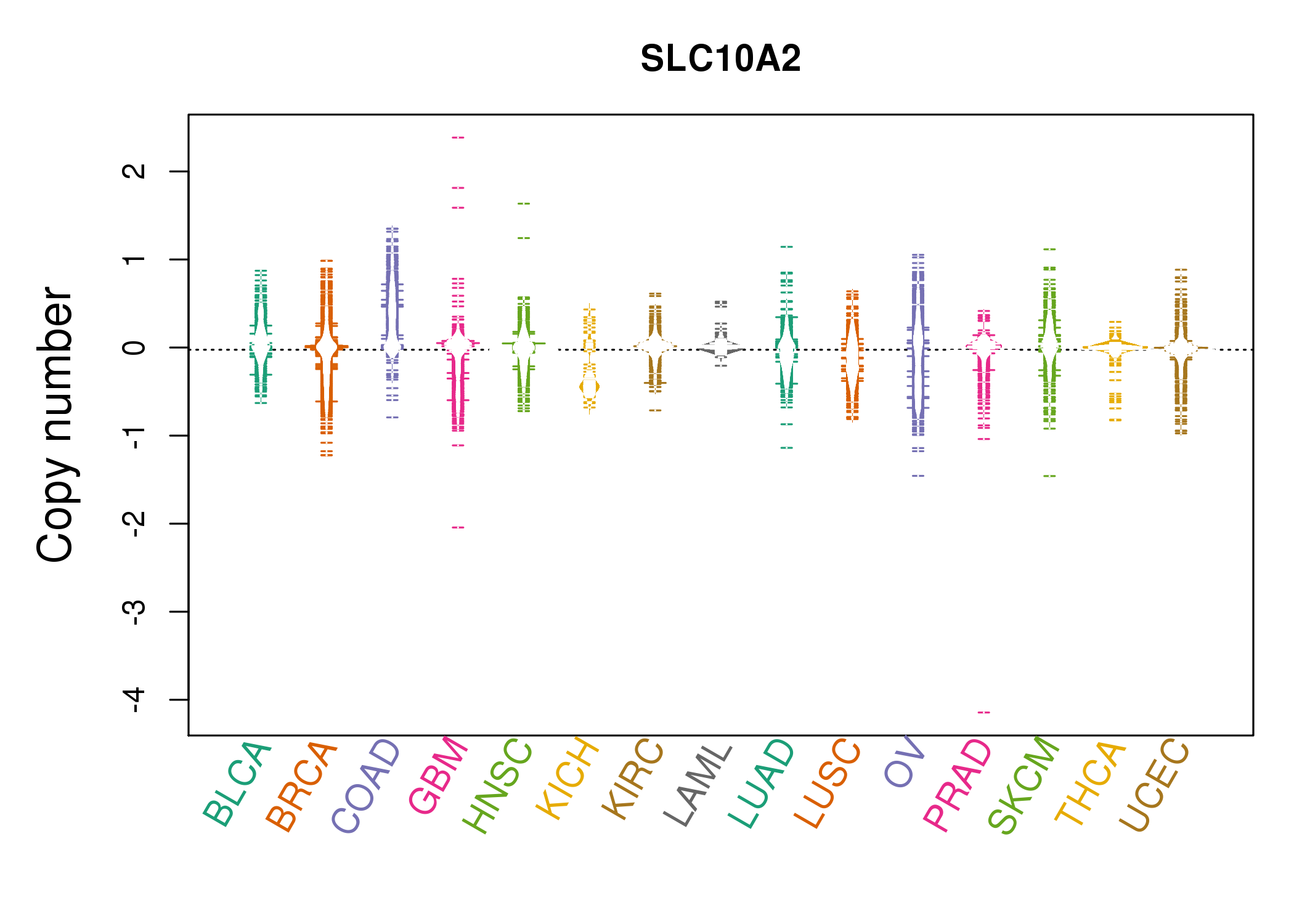 |
| cf) Tissue ID[Tissue type]: BLCA[Bladder Urothelial Carcinoma], BRCA[Breast invasive carcinoma], CESC[Cervical squamous cell carcinoma and endocervical adenocarcinoma], COAD[Colon adenocarcinoma], GBM[Glioblastoma multiforme], Glioma Low Grade, HNSC[Head and Neck squamous cell carcinoma], KICH[Kidney Chromophobe], KIRC[Kidney renal clear cell carcinoma], KIRP[Kidney renal papillary cell carcinoma], LAML[Acute Myeloid Leukemia], LUAD[Lung adenocarcinoma], LUSC[Lung squamous cell carcinoma], OV[Ovarian serous cystadenocarcinoma ], PAAD[Pancreatic adenocarcinoma], PRAD[Prostate adenocarcinoma], SKCM[Skin Cutaneous Melanoma], STAD[Stomach adenocarcinoma], THCA[Thyroid carcinoma], UCEC[Uterine Corpus Endometrial Carcinoma] |
| Top |
| Gene Expression for SLC10A2 |
| * CCLE gene expression data were extracted from CCLE_Expression_Entrez_2012-10-18.res: Gene-centric RMA-normalized mRNA expression data. |
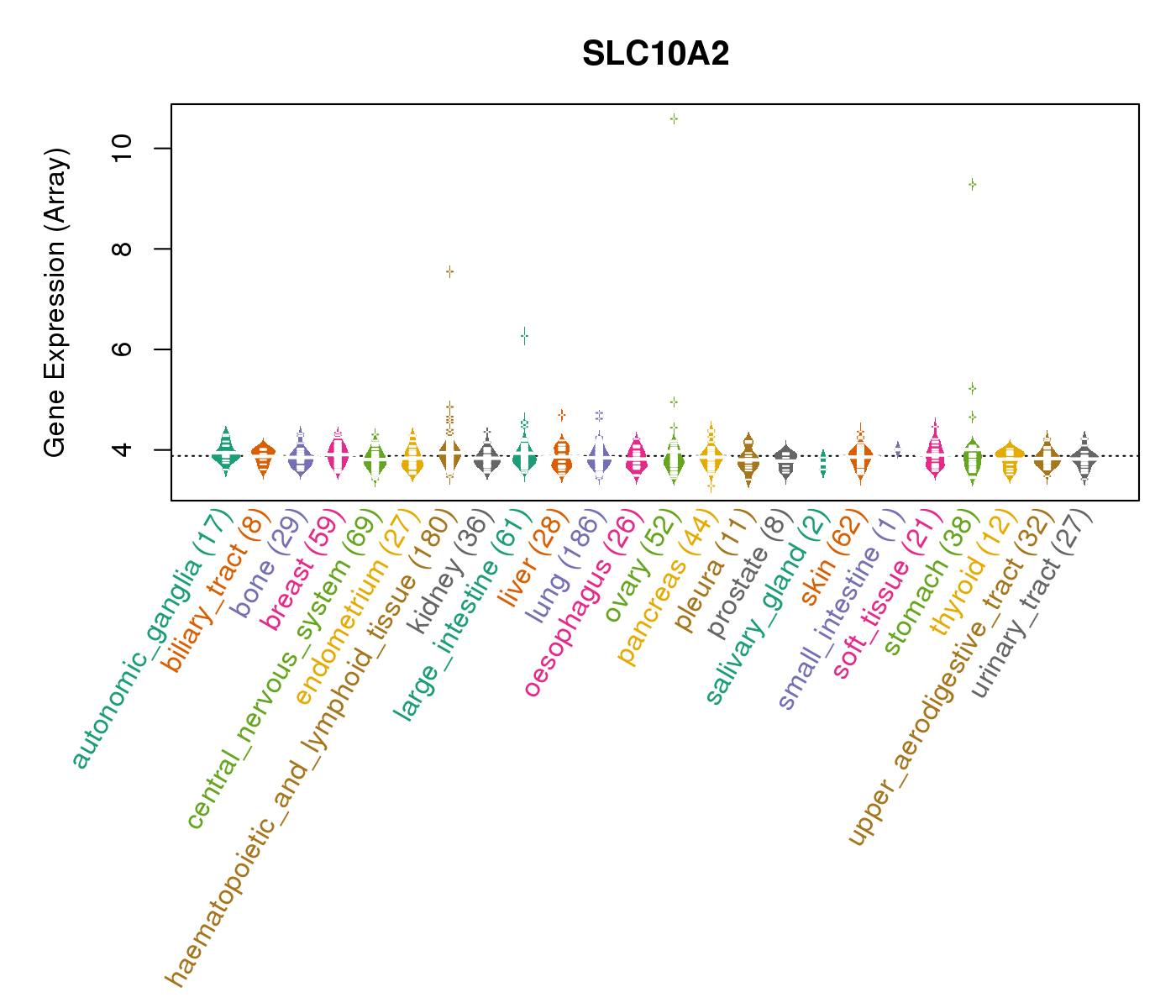 |
| * Normalized gene expression data of RNASeqV2 was extracted from TCGA using R package TCGA-Assembler. The URLs of all public data files on TCGA DCC data server were gathered at Jan-05-2015. Only eight cancer types have enough normal control samples for differential expression analysis. (t test, adjusted p<0.05 (using Benjamini-Hochberg FDR)) |
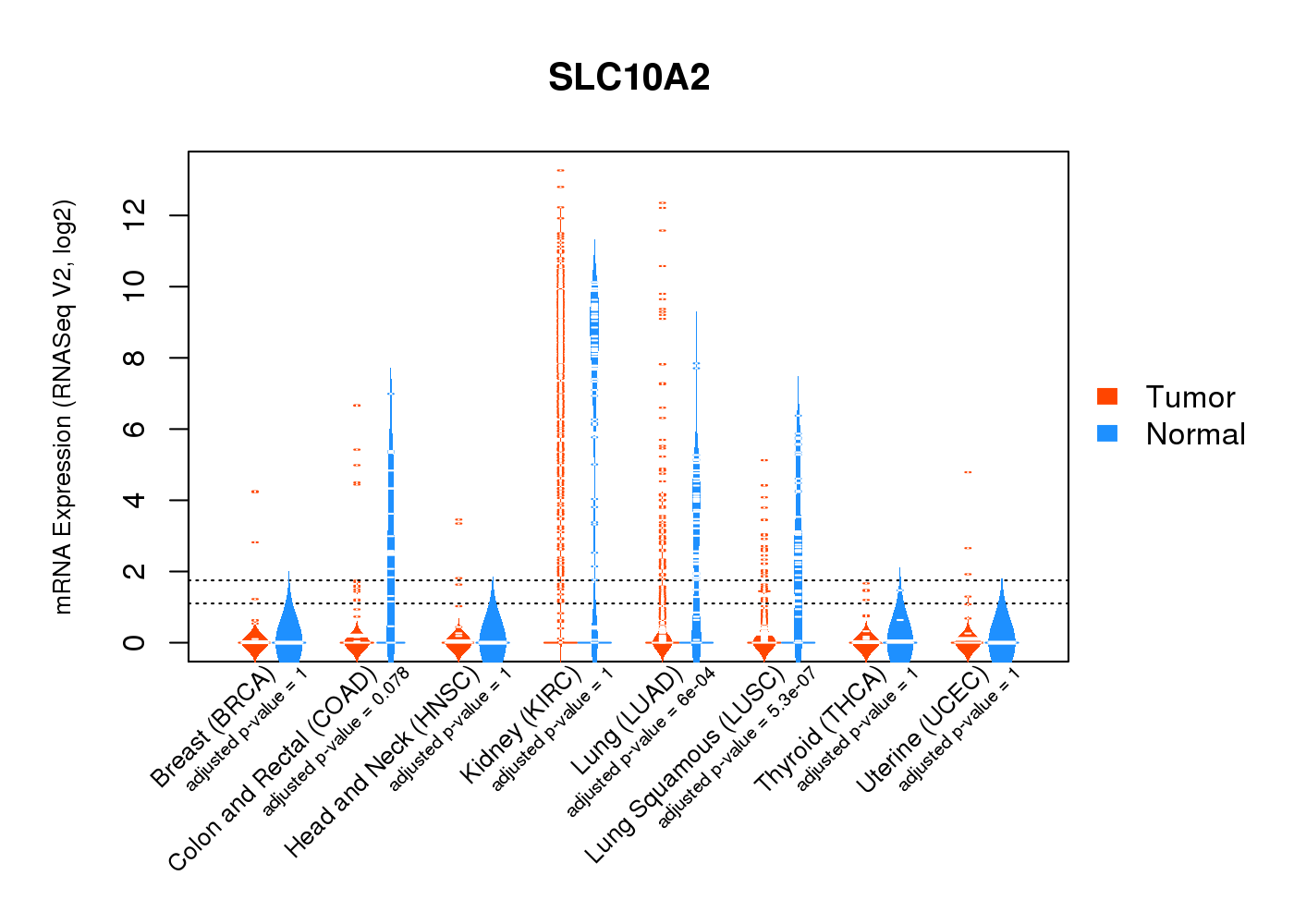 |
| Top |
| * This plots show the correlation between CNV and gene expression. |
: Open all plots for all cancer types
 |
|
 |
|
| Top |
| Gene-Gene Network Information |
| * Co-Expression network figures were drawn using R package igraph. Only the top 20 genes with the highest correlations were shown. Red circle: input gene, orange circle: cell metabolism gene, sky circle: other gene |
: Open all plots for all cancer types
 |
| ||||
| BLID,FAM228A,EGFEM1P,CARS2,F7,FAM101A,FAM150B, FEZF1,FOLH1B,IMPG1,KRT86,LCN9,LOC157627,LOC285780, OR2T11,OR6X1,PCID2,POU3F2,PTPRM,SLC10A2,TMEM27 | ACE2,VSTM5,CACNA1B,CDK5R1,ESRRB,INPP5D,KRTAP4-12, LCT,OR51F2,OR9A4,PIWIL4,PSORS1C2,SCARNA8,SLC10A2, SNORA13,SPINK5,TBX10,TDO2,TGFA,TUBA4B,VSIG10L | ||||
 |
| ||||
| C1orf61,CABS1,CCDC108,CCR9,CLCN1,CRISP1,EPHX3, FAM131B,FAM99A,FAM99B,GOLGA6D,HS6ST3,NWD2,KRT76, LOC415056,MT1B,OR2A12,OR4C15,SFRP5,SLC10A2,TRPM5 | AADAC,APOA1,APOA4,APOB,APOC3,C17orf78,CCL25, CPO,CRISP1,CUBN,DPEP1,FABP6,GSTA2,GSTA5, KCNJ13,ONECUT3,SLC10A2,SL |
| * Co-Expression network figures were drawn using R package igraph. Only the top 20 genes with the highest correlations were shown. Red circle: input gene, orange circle: cell metabolism gene, sky circle: other gene |
: Open all plots for all cancer types
| Top |
: Open all interacting genes' information including KEGG pathway for all interacting genes from DAVID
| Top |
| Pharmacological Information for SLC10A2 |
| DB Category | DB Name | DB's ID and Url link |
| Chemistry | BindingDB | Q12908; -. |
| Chemistry | ChEMBL | CHEMBL2778; -. |
| Chemistry | GuidetoPHARMACOLOGY | 960; -. |
| Organism-specific databases | PharmGKB | PA318; -. |
| Organism-specific databases | CTD | 6555; -. |
| * Gene Centered Interaction Network. |
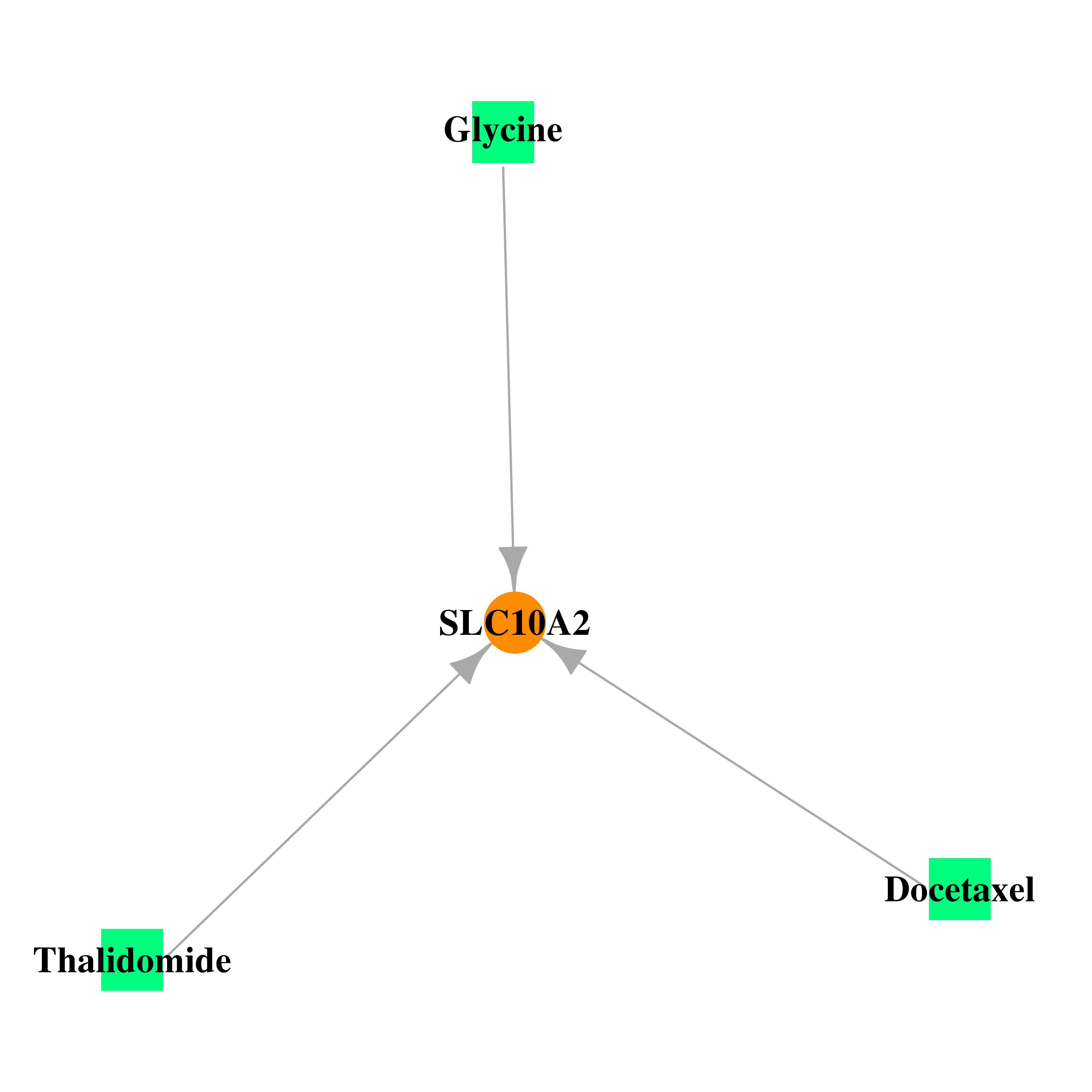 |
| * Drug Centered Interaction Network. |
| DrugBank ID | Target Name | Drug Groups | Generic Name | Drug Centered Network | Drug Structure |
| DB01248 | solute carrier family 10 (sodium/bile acid cotransporter family), member 2 | approved; investigational | Docetaxel |  | 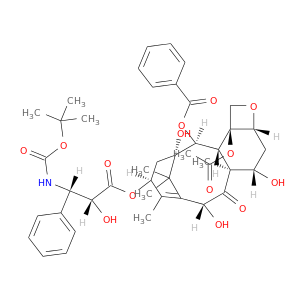 |
| DB01041 | solute carrier family 10 (sodium/bile acid cotransporter family), member 2 | approved; withdrawn; investigational | Thalidomide |  | 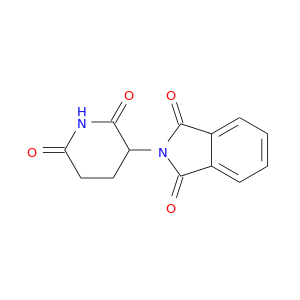 |
| DB00145 | solute carrier family 10 (sodium/bile acid cotransporter family), member 2 | approved; nutraceutical | Glycine | 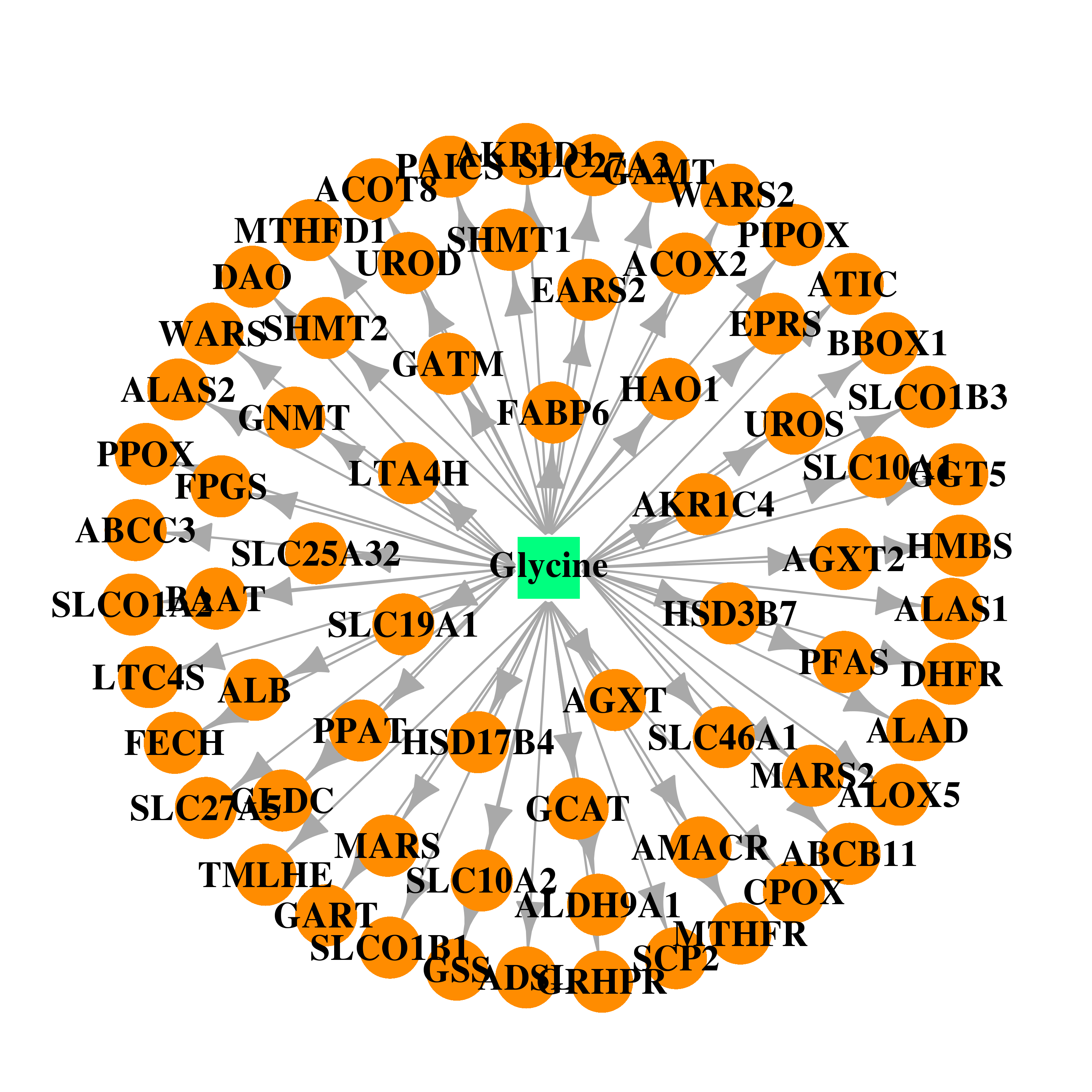 | 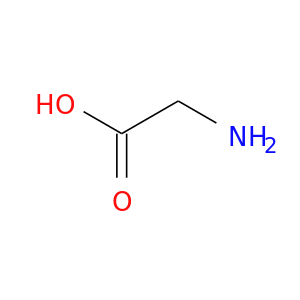 |
| Top |
| Cross referenced IDs for SLC10A2 |
| * We obtained these cross-references from Uniprot database. It covers 150 different DBs, 18 categories. http://www.uniprot.org/help/cross_references_section |
: Open all cross reference information
|
Copyright © 2016-Present - The Univsersity of Texas Health Science Center at Houston @ |








